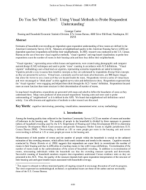
An official website of the United States government
Here’s how you know
Official websites use .gov
A .gov website belongs to an official government organization in the United States.
Secure .gov websites use HTTPS
A lock (
) or https:// means you’ve safely connected to the .gov website. Share sensitive information only on official, secure websites.
-
//
- Census.gov /
- Library /
- Census Working Papers /
- Do You See What I See? Using Visual Methods to Probe Respondent Understanding
Do You See What I See? Using Visual Methods to Probe Respondent Understanding
Do You See What I See? Using Visual Methods to Probe Respondent Understanding
Estimates of household overcrowding are dependent upon respondent understanding of how rooms are defined in the American Community Survey (ACS). Measures of neighborhood quality in the American Housing Survey (AHS) are dependent upon how respondents self-define their neighborhoods. In 2007, research was conducted at the U.S. Census Bureau on the use of two new visual cognitive methods, “visual vignettes” and map-based visualization, to probe how respondents count the number of rooms in their housing units and how they define their neighborhoods.
“Visual vignettes,” representing areas within houses and apartments, were created using photographic and computer assisted design (CAD) techniques and used to probe “room” counting in accordance with ACS definitions. “Visual vignette” methodology uses virtual tours as vignettes, representing scenarios respondents are asked to interpret. Vignettes provide a way to assess how intuitive concepts as they are understood by respondents diverge from concepts as they are presented in surveys. Virtual tours, commonly used in real estate advertisements, are 360 degree images that allow the viewer to see a room as if they are located inside the room. Respondents viewed a series of virtual tours and were encouraged to “think aloud” as they applied survey rules and definitions to them. Respondents expressed that the “visual vignettes” were engaging and helped them think through the ACS “rooms” definition. Respondents focused more on room function than room structure in their determination of number of rooms.
In map-based visualization, respondents are presented with maps and asked to define the boundaries of areas as they understand them. Maps were produced of areas around respondents’ housing units and were used to probe understanding of “neighborhood” as it is defined in the AHS. We found that neighborhood self-definitions varied widely. Cost effectiveness and application of methods to other research are discussed.
Share
Some content on this site is available in several different electronic formats. Some of the files may require a plug-in or additional software to view.
 Yes
Yes
 No
NoComments or suggestions?


Top

